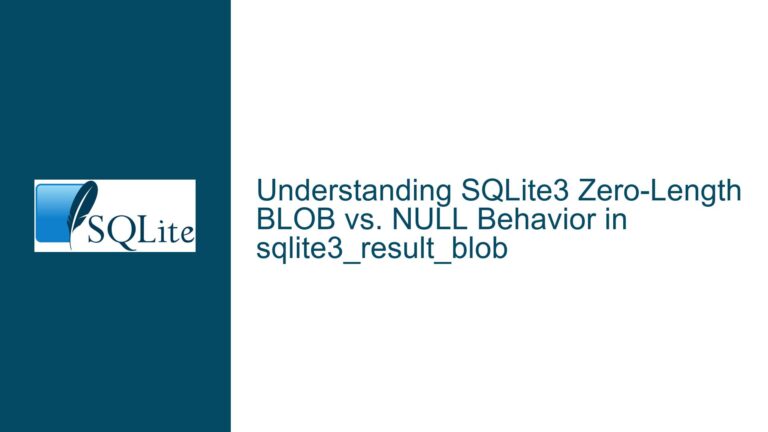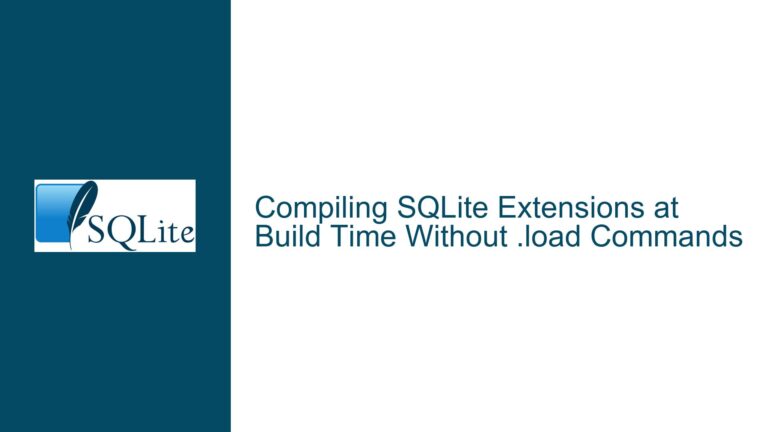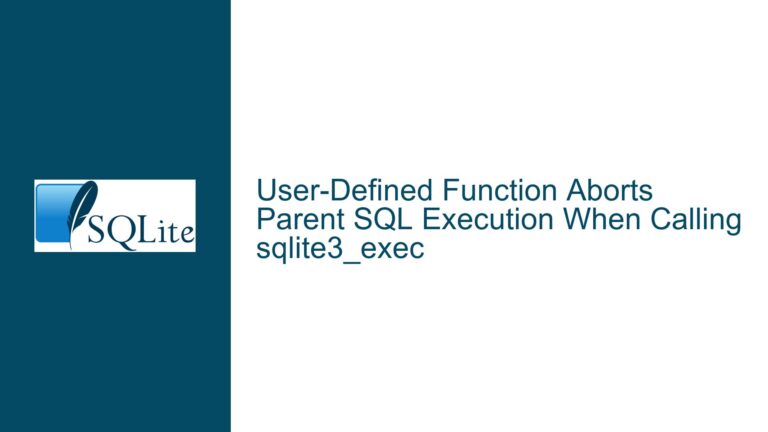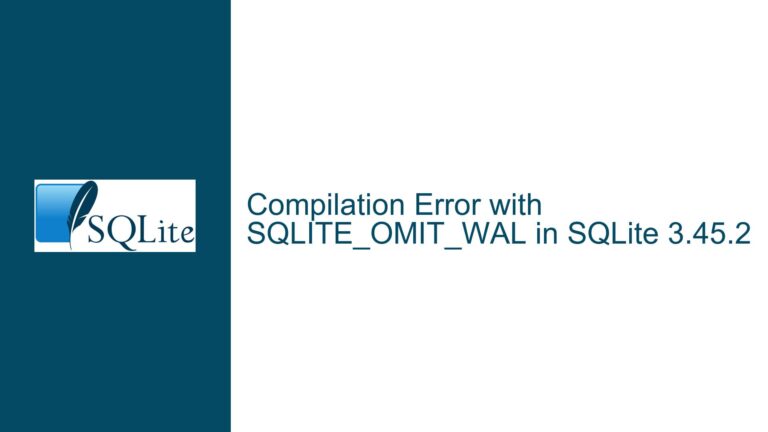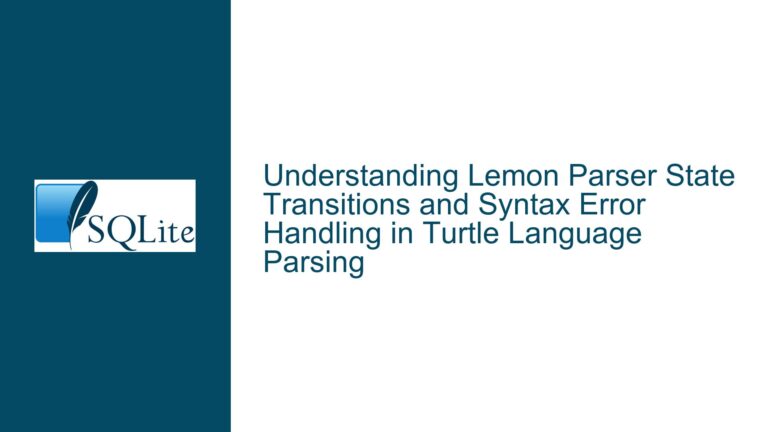SQLite Database File Creation in sqlite3.c
Issue Overview: Identifying the Exact Point of Database File Creation in sqlite3.c
When working with SQLite, one of the most fundamental operations is the creation of a new database file. This operation is typically initiated using the sqlite3_open_v2() function, which is designed to open a database connection and, if necessary, create a new database file. However, the exact point in the SQLite source code where the database file is actually created is not immediately obvious, especially for those who are not deeply familiar with the internal workings of SQLite.
The core issue revolves around understanding the sequence of operations that occur within the SQLite source code, specifically in the sqlite3.c file, when a new database file is created. The question is: At which line or section of the sqlite3.c file does SQLite explicitly create a new database file when the sqlite3_open_v2() function is called with the SQLITE_OPEN_CREATE flag?
To answer this question, we need to delve into the SQLite source code, particularly focusing on the sqlite3_open_v2() function, the VFS (Virtual File System) layer, and the operating system-specific file handling code. The goal is to trace the execution path from the initial call to sqlite3_open_v2() down to the point where the actual file creation occurs.
Possible Causes: Why the Database File Creation Point is Not Immediately Obvious
The complexity in identifying the exact point of database file creation in SQLite arises from several factors:
Lazy Initialization: SQLite employs a lazy initialization strategy, meaning that it delays certain operations until they are absolutely necessary. This includes file creation. When
sqlite3_open_v2()is called, SQLite does not immediately create the database file. Instead, it waits until the first operation that requires file access, such as a write operation, is performed.VFS Abstraction Layer: SQLite uses a Virtual File System (VFS) layer to abstract away the details of file operations. This allows SQLite to be portable across different operating systems. The VFS layer is responsible for handling all file-related operations, including file creation. The actual file creation code is therefore buried within the VFS implementation, which varies depending on the operating system.
Flag Combinations and Validation: SQLite performs a series of checks on the flags passed to
sqlite3_open_v2()to ensure that they are sensible. For example, theSQLITE_OPEN_CREATEflag must be accompanied by theSQLITE_OPEN_READWRITEflag. These checks occur before the VFS layer is invoked, adding another layer of complexity to the code path.Operating System-Specific Code: The actual file creation code is implemented in operating system-specific files, such as
os_win.cfor Windows. This means that the exact location of the file creation code depends on the platform being used.
Given these factors, it becomes clear why pinpointing the exact line of code where the database file is created is not straightforward. The process involves tracing through multiple layers of abstraction, flag validation, and platform-specific code.
Troubleshooting Steps, Solutions & Fixes: Tracing the Database File Creation in sqlite3.c
To identify the exact point in the sqlite3.c file where the database file is created, we need to follow a systematic approach that involves tracing the execution path from the sqlite3_open_v2() function down to the operating system-specific file creation code. Here’s a detailed step-by-step guide to achieving this:
Step 1: Understanding the sqlite3_open_v2() Function
The sqlite3_open_v2() function is the entry point for opening a database connection in SQLite. It takes four parameters: the database filename, a pointer to the database handle, flags that control the opening behavior, and the name of the VFS module to use. The flags parameter is particularly important because it determines whether a new database file should be created if it does not already exist.
The relevant flags for our discussion are:
SQLITE_OPEN_READWRITE: Opens the database for reading and writing.SQLITE_OPEN_CREATE: Creates the database file if it does not already exist.SQLITE_OPEN_FULLMUTEX: Enables serialized threading mode.
When sqlite3_open_v2() is called with the SQLITE_OPEN_CREATE flag, SQLite will attempt to create the database file if it does not already exist. However, as mentioned earlier, this does not happen immediately.
Step 2: Tracing the Execution Path in sqlite3.c
To trace the execution path, we start by examining the sqlite3_open_v2() function in the sqlite3.c file. The function begins by validating the flags passed to it. Specifically, it checks that the SQLITE_OPEN_CREATE flag is accompanied by the SQLITE_OPEN_READWRITE flag. This check is performed in the following code block:
if( (flags & SQLITE_OPEN_CREATE) && !(flags & SQLITE_OPEN_READWRITE) ){
return SQLITE_MISUSE;
}
This code ensures that the SQLITE_OPEN_CREATE flag is only used in conjunction with the SQLITE_OPEN_READWRITE flag. If this condition is not met, the function returns an error.
After validating the flags, sqlite3_open_v2() proceeds to open the database file. However, the actual file creation is deferred until the first operation that requires file access. This is where the VFS layer comes into play.
Step 3: Exploring the VFS Layer
The VFS layer is responsible for handling all file-related operations in SQLite. When sqlite3_open_v2() is called, it eventually invokes the sqlite3OsOpen() function, which is part of the VFS layer. This function is responsible for opening the database file and, if necessary, creating it.
The sqlite3OsOpen() function is implemented in the operating system-specific code. For example, on Windows, this function is implemented in the os_win.c file. To find the exact location of the file creation code, we need to examine the os_win.c file.
Step 4: Locating the File Creation Code in os_win.c
In the os_win.c file, the sqlite3OsOpen() function is implemented as winOpen(). This function is responsible for opening the database file and creating it if it does not already exist. The relevant code block is as follows:
if( flags & SQLITE_OPEN_CREATE ){
dwCreationDisposition = CREATE_ALWAYS;
} else {
dwCreationDisposition = OPEN_EXISTING;
}
This code checks if the SQLITE_OPEN_CREATE flag is set. If it is, the CREATE_ALWAYS flag is passed to the CreateFile() function, which is a Windows API function that creates a new file or opens an existing file. If the file does not exist, it is created. If it does exist, it is truncated to zero length.
The actual file creation occurs when the CreateFile() function is called with the CREATE_ALWAYS flag. This is the point in the code where the database file is created.
Step 5: Verifying the File Creation
To verify that the database file has been created, you can check the return value of the sqlite3_open_v2() function. If the function returns SQLITE_OK, it means that the database file was successfully opened or created. You can also use a file system call to check if the file exists at the specified path.
Step 6: Summary of the File Creation Process
To summarize, the process of creating a new database file in SQLite involves the following steps:
- The
sqlite3_open_v2()function is called with theSQLITE_OPEN_CREATEflag. - The function validates the flags and ensures that
SQLITE_OPEN_CREATEis accompanied bySQLITE_OPEN_READWRITE. - The function invokes the VFS layer to open the database file.
- The VFS layer, implemented in
os_win.cfor Windows, checks if theSQLITE_OPEN_CREATEflag is set. - If the flag is set, the
CreateFile()function is called with theCREATE_ALWAYSflag, which creates the database file if it does not already exist. - The
sqlite3_open_v2()function returnsSQLITE_OKif the file was successfully opened or created.
By following this step-by-step guide, you can trace the exact point in the SQLite source code where the database file is created. This understanding is crucial for debugging and optimizing SQLite-based applications, especially when dealing with file creation and access issues.
Conclusion
Identifying the exact point of database file creation in SQLite requires a deep dive into the source code, particularly the sqlite3_open_v2() function and the VFS layer. The process involves understanding the lazy initialization strategy employed by SQLite, the role of the VFS layer in abstracting file operations, and the operating system-specific code that handles file creation. By following the steps outlined in this guide, you can pinpoint the exact location in the sqlite3.c file where the database file is created, enabling you to better understand and troubleshoot SQLite-based applications.

